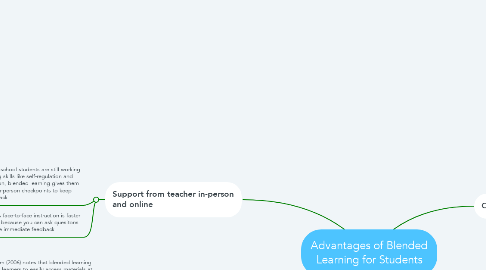Advantages of Blended Learning for Students
создатель Alicia Munnings

1. Increased access & flexibility
1.1. Graham (2006) notes that blended learning allows learners to easily access materials at home, since resources are posted online. This gives students flexibility to work independently at their own pace at home. They can review more if needed.
1.1.1. Graham, C. R. (2006). Blended learning systems. The handbook of blended learning, 3-21.
1.2. Since there is also in-class time, students can check-in in person if they need live help from a teacher.
2. Support from teacher in-person and online
2.1. Since high school students are still working on learning skills like self-regulation and organization, blended learning gives them the extra in-person checkpoints to keep them on track.
2.2. Sometimes face-to-face instruction is faster and better because you can ask quesitons and receive immediate feedback.
3. Disadvantages of Online = Fixed by Blended!
3.1. The disadvantages of fully online learning (social isolation, maintaining engagement, easily distracted, independent learning skill deficits), can be mediated by the in-class meetings. Teachers can focus on these aspects in-class.
4. Online Resources and Technology
4.1. Internet is a wealth of information
4.2. Sharing and collaborating is easy with Google classroom and google drive
4.3. Students can use videos to learn, don't always need lecture from teacher, then in class time can be used to help with problems (flipped classroom)
5. Community Engagement of Face-to-face classroom
5.1. Many online platforms are trying to mimic the interactivity of face-to-face classroom through chats and video. Blended is best because it allows for face-to-face connection, social interaction, and building relationships.
5.2. In public school system, having a live interaction in the classroom is a good way to care for students, and means young people have relationships with responsible adult role models.



